
3 Ways to Fake GPS Without Root On Samsung Galaxy M34 | Dr.fone

3 Ways to Fake GPS Without Root On Samsung Galaxy M34
Fake GPS is an Android application for tweaking your GPS settings. It will help you avoid being tracked by your parents or a stranger spying on you in many situations. Faking GPS will also aid you in using an application that is banned in your region or playing a trick in the games like Pokemon Go.
In other words, it is called GPS spoofing. Some users believe in a misconception that the Samsung Galaxy M34 device will have to be rooted for GPS spoofing. But that’s wrong. It’s possible to alter the location without rooting your phone. If you have no idea how to fake GPS no root and want to know more, keep reading this article. We created this guide to curb your worries and help you fix your issue! Let’s begin now!
Part 1: The one-stop way to fake GPS on your iOS and Android without root
Have trouble catching Pokemon? Or maybe you’re trying to get a date. Whatever your reason, with Dr. Fone’s Virtual Location, you can quickly teleport your phone to anywhere in the world with a single click. You can even move along a route that you draw!
Try it with location-based apps like Pokemon Go or Tinder to fake movement and enjoy all the fun on the go. It works perfectly with any application to fake GPS without root. The app is compatible with Windows and macOS devices to use any of them for GPS spoofing on your smartphone.
Dr.Fone - Virtual Location
1-Click Location Changer for both iOS and Android
- Teleport from one location to another across the world from the comfort of your home.
- Fake GPS location on Android without root.
- Stimulate and imitate movement and set the speed and stops you take along the way.
- Compatible with both iOS and Android systems.
- Work with location-based apps, like Pokemon Go , Snapchat , Instagram , Facebook , etc.
3981454 people have downloaded it
Steps to fake GPS no root on your iOS and Android
Step 1: Download Dr. Fone
Download Dr.Fone – Virtual Location on your PC and run it to begin fake GPS without root. Then, choose “Virtual Location” from the given options from the home interface.

Step 2: Connect Your Device
Connect your iOS device with the lightning cable or your Samsung Galaxy M34 using a USB cable. You can also connect your iOS device via WiFi after being connected once. Click on “Get Started” now.
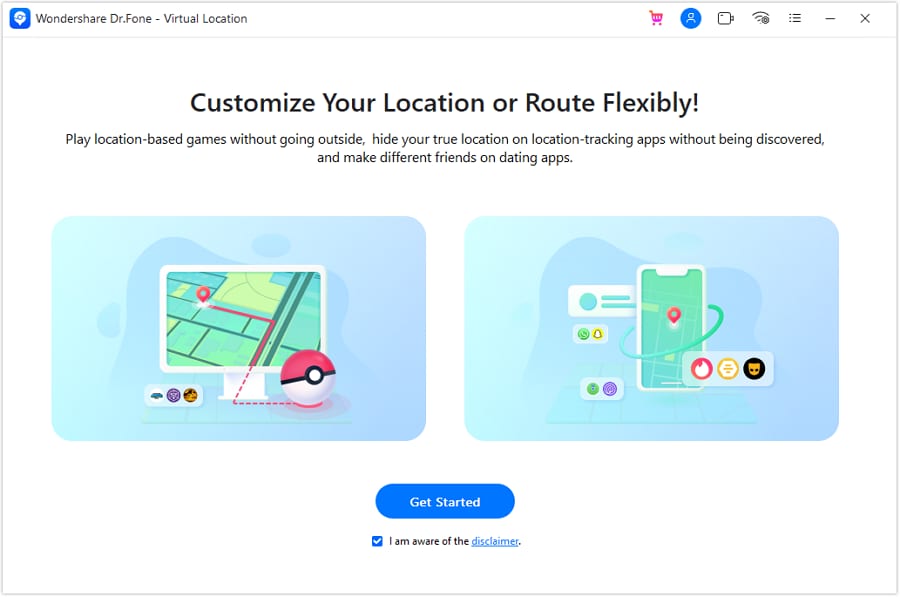
Step 3: Set the Accurate Location
Before GPS spoof without root, you have to find and set your actual location on the map. If the location is not shown correctly, hit the “Center On” icon located at the lower right part.
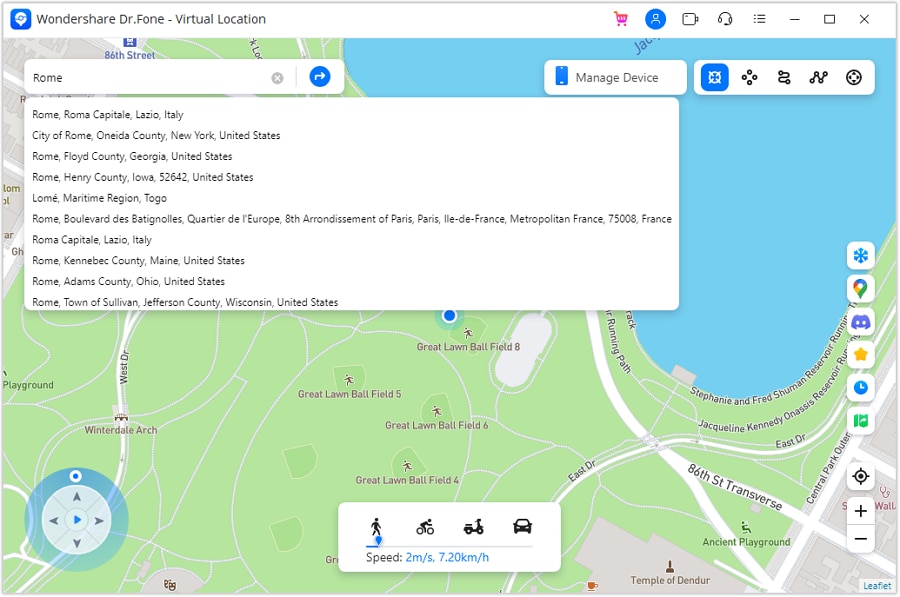
Step 4: Turn on Teleport Mode
Click the second icon present in the upper right to turn on the “teleport mode.” Now, type where you want to teleport in the space given on the top left. After that, click “Go” to start a fake GPS with no root.

Step 4: Chance the Location
Now, you will be able to trick all the location-based apps with your fake location. Click on “Move Here” when the popup box shows.
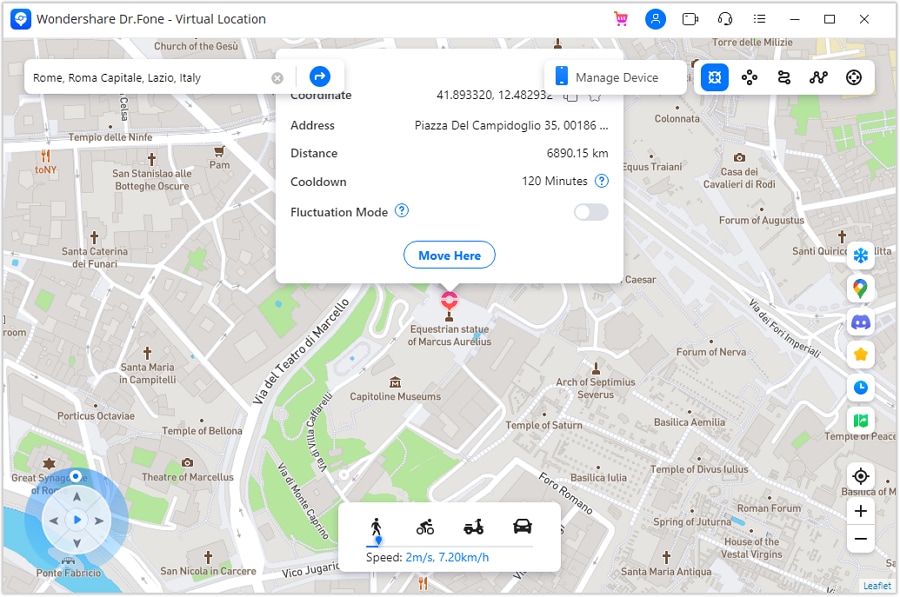
Even when you click the “Center On” icon for location yourself, the location will remain fixed to where you have done teleporting.
Part 2: Other APPs to fake GPS without jailbreak no root
Fake GPS Location – Hola
Other than Dr.Fone, you can use its alternative Hola on Android devices. It’s available to use in more than 43 languages free of cost. With this fake GPS Android no root application, you can choose from an extensive list of places worldwide to set your location. For android users who can’t afford a PC or laptop to perform GPS spoofing with Dr.Fone, they can choose Hola for convenience.

Pros
- Quick to alter the location to wherever you want in the world.
- Pretty easy to use by anyone you wish without any hassle.
- You will not see any ads.
- The interface is user-friendly.
Cons
- Many times, the cursor doesn’t work correctly.
- It can drain your device’s battery, unlike Dr.Fone – Virtual Method.
Fake GPS Go Location Spoofer
Fake GPS Go Location Spoofer is a perfect solution for those looking for a reliable GPS spoofer. It is available as an app, eliminating the need to be rooted to use it. Additionally, it’s incredibly simple to use and can fool all Geo-location based applications on your device.
You’ll have fun letting your friends think you’re partying like a rock star or relaxing on some tropical island while they are stuck at the office or school doing work.

Pros
- It can be used with a joystick to match the movement on the screen.
- It can be integrated with other third-party applications using the share button.
- Helps in altering location change frequency.
- You can customize routes easily.
Cons
- It Consumes too much battery.
- It doesn’t work on all GPS-related apps.
GPS Emulator
GPS emulator is another such application that helps you in fake GPS no root. If you’re looking to fake your location without too many advanced features, this might be for you. It’s straightforward, and it gets the job done quickly. It demands modification in your Samsung Galaxy M34 setting like turning on the developer mode, deactivating mock location, etc.

Pros
- Provides access to three map types for allowing you to teleport location conveniently.
- Permit you to enable or disable GPS coordinates injection for Google services.
- Easy switching to a different map mode.
- Easy to use.
Cons
- No updates for so long.
- May heat up the phone if used for long.
Conclusion
If you plan to root your device to fake GPS without mock location no root, drop that idea. You are now aware of some of the best ways to fake GPS without rooting your device. It’s highly recommended to use Dr.Fone - Virtual Location when you want to do more and change your GPS location.
What is Geo-Blocking and How to Bypass it On Samsung Galaxy M34?
Have you ever entered a website and can’t access it because it is unavailable in your area? This is what geo-blocking means. If you want to know more about geo-blocking, you have come to the right article. This article provides the definition, symbols, function, type, and how to bypass a geo-blocked site.
Encryption is often used in geo-blocking as a means of protecting material that is restricted to users in just certain locations. In its long existence, the method has been met with several obstacles. These obstacles will be discussed in the next sections!

Part 1. What is Geo-Blocking?
This section will give you the definition of geo-blocking. It will also show how websites inform viewers that they are in geo-blocking areas.
Definition of Geo-Blocking
Geo-blocking is the practice of restricting online access to certain users depending on where in the world they happen to be physically located. Telecommunications firms, websites, and other content providers and intellectual property owners often use this method for copyright protection. To monitor and enforce geo-blocks, databases that map out IP addresses’ geographical locations are often employed.
Understanding the Main Symbols and Elements
You sometimes can’t access a site because it isn’t available in your area. This is the main element carried by geo-blocking.
Every online-surfing tool has a unique identifier called “IP address”. The address can identify the Samsung Galaxy M34 devices’ geographical location. When users access a website, their devices send their IP addresses to the online servers. The servers read if the IP addresses are included in the allowed list and determine whether to allow the visitors to view the content.
The visitors usually know they are geographically limited through the website’s displayed outcomes, a poster indicating that the service is unavailable in the location. Take the geo-banned access by Airbnb as an example below.
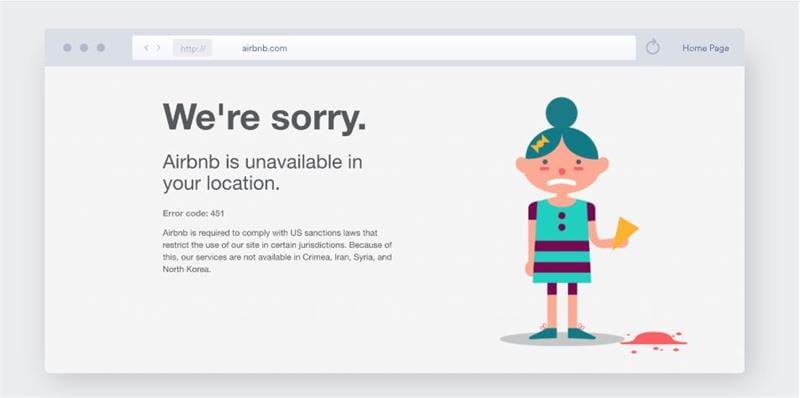
Although Airbnb has been criticized for posing a threat to the availability of low-cost lodging in metropolitan areas, it has proven to be a useful resource for travelers. However, not everyone can use it; for instance, it is unavailable in Iran due to US sanctions.
Part 2. How Does Geo-Blocking Work?
When a firm, rather than a government, is responsible for geoblocking, IP addresses are often the first line of defense. Your IP address is like a street address, revealing where you live.
IP addresses are numerical identifiers that distinguish each machine on the internet. Your computer’s IP address is sent to the server of the website you visit so that it may supply the required data.
You’ll be assigned an IP address when you sign up for an Internet Service Provider. It is possible to pinpoint the location of your device using its IP address, albeit the degree of precision may vary. Websites use the IP address to determine whether you can read their content. They will thus refuse your request if you are using an IP address that’s not on their approved list.
Part 3. Common Types of Geo-blocked Content
The difficulty stems from legal hurdles, including copyrights, licenses, and territorial disputes. Certain streaming services may not make all of their offerings accessible in all regions, or a major online shop may restrict some of their offerings to customers in just one geographic area.
Youtube
Users who upload videos can restrict access to them in certain countries. This nearly usually indicates that a business has chosen that you shouldn’t be able to see a video because of where you are located.

Spotify
You may be trying to find a method to unblock Spotify because you want to listen to unavailable music in your country or because the app has been prohibited in your area.

Live Sports
Big events may be aired exclusively by one company, which means you may be forced to pay to access certain material or go through annoying subscription hoops.

Pandora
Do you want to tune in to this online radio and music station? You can’t access it anywhere in Europe because of a regional firewall.

Porn sites
Artists from porn sites can now geo-block their movies, much like YouTube users do. Some porn sites have been outlawed in several countries, including Egypt and Pakistan, where the vast majority of the population resides.

Amazon
Amazon Prime geo-blocks other services as well as its streaming content. Games, ebooks, software, audiobooks, and other digital materials like TV and movies may be licensed and copyrighted. Amazon Prime prevents certain VPN IPs from accessing foreign content, including Netflix.

Part 4. Tips to Bypass Geo-Blocking
While certain sites may be blocked in your country, there are still methods to access the full functionality of the web. What exactly are they, and how do you go about getting them? Here’s more reading material.
Method 1. Use Smart Domain Name System (DNS)
Clever DNS can evade geoblocking if your smart TV, streaming box, or gaming console doesn’t support VPNs or proxy servers. Some home routers can generate VPN connections, but not all.
By changing your DNS address, clever DNS may alter your device’s virtual location. Smart DNS replaces your Internet provider’s DNS server. Netflix.com’s IP is not netflix.com. You’ll acquire the smart DNS provider’s transparent DNS proxy IP. Netflix thinks you’re in the US since this proxy server is.
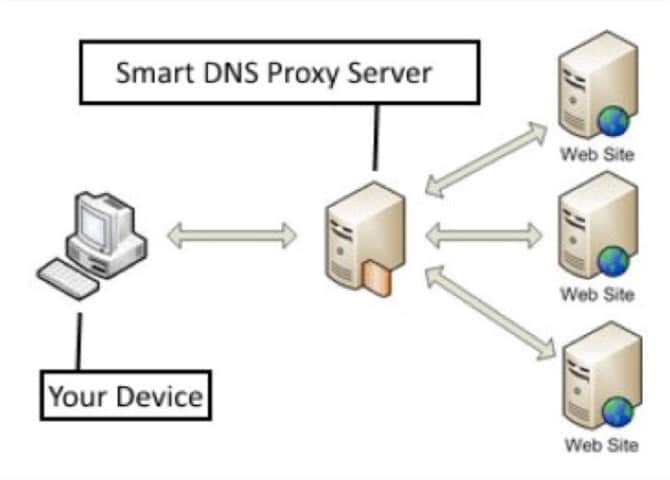
Method 2. Connect to Proxy Servers
Rather than connecting you directly to the server housing the material you want, a proxy server functions as an intermediary. A proxy server does what its name implies: it acts on your behalf to get access to the data and then forwards it to you. Proxy servers, especially those in foreign countries, may be used to get around geographical restrictions.
Depending on the kind of proxy server you use, you may or may not be able to conceal your IP address when surfing the web. Proxy servers are available online and may be accessed from any web browser. Setting up a proxy server is easy, but your activity may still be vulnerable since proxies don’t secure your data.
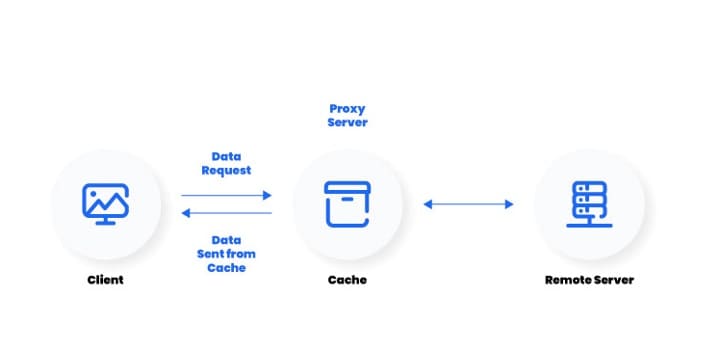
Method 3. Use the Tor Browser
In addition to using a VPN, you may use the anonymous Tor browser. The Tor browser links to the Tor network, a collection of computers that collaborate to conceal your online footprint by relaying your traffic via several intermediary nodes.
Tor employs a technique called “onion routing” to conceal its users’ identities. Since more time is required to traverse these additional levels, your internet speed may suffer as a consequence.
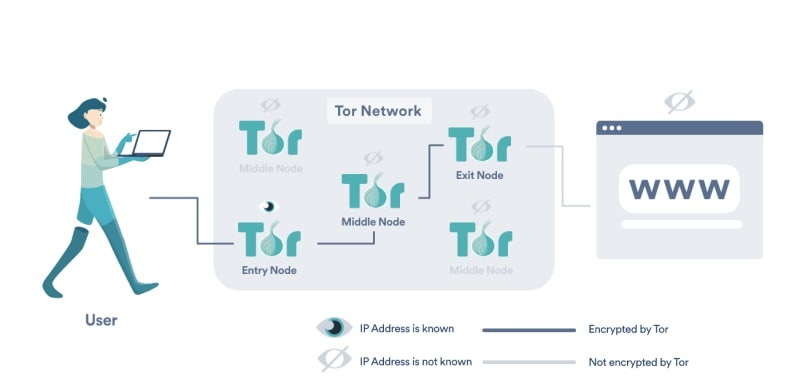
Method 4. A Good VPN Connection
A virtual private network (VPN) may hide your online identity and protect your data by encrypting your connection. VPNs allow you to get around geographically restricted material by redirecting your connection via a server in another country. This will allow you to connect to VPN servers in other countries, such as the United States, the United Kingdom, or Australia.
With effective VPN tools , you can surf the web anonymously, unblock geo-blocked content, and watch your favorite programs abroad. There are several advantages to utilizing a VPN, particularly when you travel or use public Wi-Fi, and they are simple to set up.

Part 5. FAQs About Geo-Blocking
Here are the answers to four questions that you might ask about geo-blocking.
1. Is Geo-Blocking Legal?
Yes. It’s legitimate. Limiting access to websites and services based on a user’s location is lawful. This practice is routinely used in nations like China to prevent citizens from seeing politically sensitive material. Legal arrangements, such as licensing agreements, may also be enforced by geo-blocking.
2. Is Bypassing Geo Blocking Illegal?
It depends. Depending on the situation, the nation, the purpose of the use, and the technique used, geo-blocking circumvention may be against the law. Copyright regulations prohibit users from accessing material beyond its designated location, yet many providers are reluctant to penalize users for doing so.
3. What’s the Difference Between Geo-Fencing and Geo-Blocking?
Geo-fencing is to create digital fences on which to base real-world judgments about where to go. One may draw a boundary around it using longitude and latitude lines on a map to easily establish who is permitted inside a certain region. Restricting access to material based on a user’s physical location is called “geo-blocking.”
4. Is Geo-Restricted the Same as Geo-Blocking?
They are the same. Restricting a user’s ability to access certain online resources depending on their location is known as geo-blocking or geo-restriction. To safeguard their license agreements, foreign media streaming firms often use the practice of geo-blocking.
Conclusion
For several reasons, media and content producers use geo-blocking. Although geo-blocking is unlikely to ever go out of style, there are techniques to circumvent it. Use a virtual private network (VPN) to bypass geo-restrictions on the material you want to watch. Using a Virtual Private Network (VPN), a proxy server, the Tor network, etc., your online location may be hidden or masked.
Geo-blocking controls. It’s both useful and abused. Website banning discriminates and manipulates. Geography may be annoying and frustrating. Sadly, they may always be in style. You don’t have to tolerate them!
Is pgsharp legal when you are playing pokemon On Samsung Galaxy M34?
Pokémon Go is the phenomenon that hit us in 2016 and made us obsessed with the AR game based on real-time location. If you are one of those players who have been to all the local PokeStops in hopes of finding your favorite rare Pokémon, then it might be time for you to consider spoofing your location while playing PoGo.

Pokémon Go relies on GPS coordinates and real-time tracking to let players catch Pokémon s in real locations. Hence, spoofing comes to the discussion of “catching them all.”
‘Spoofing’ location makes your phone, and thereby the game thinks that you’re in another location, which opens up the possibility to catch new and rare Pokémon s from gyms and PokeStops around the world.
Part 1: Is Pgsharp legal?

No game developer likes to see their game played in unfair ways. Thus, Niantic (PoGo’s Dev) made some strict rules against exploiting their game, giving some players an unfair advantage over others.
So, is PGSharp legal? No, Spoofing location, in general, is illegal. Hence, any apps like PGSharp, or Fake GPS Go, used to disguise actual real-time location and fake it, will result in an account ban.
According to Niantic’s terms and conditions:
- “Using any techniques to alter or falsify a device’s location (for example through GPS spoofing).
- And _”_Accessing Services in an unauthorized manner (including using modified or unofficial third party software).”
If Niantic detects usage of a fake location or GPS spoofing app while playing Pokémon Go, they will impose a strike on your account.
- The first strike would make rare Pokémon s not visible to you for seven days.
- The second strike would temporarily ban you from playing the game for 30 Days.
- The third strike will permanently ban your account.
You can appeal these strikes to Niantic if you think you’ve been banned without violation of any terms.

Part 2: Three ways to spoof on Android
- PGSharp :

PGSharp is one of the most reliable ways to spoof your location while playing Pokémon Go. Niantic does not easily recognize its simple map-like UI as a fake location app.
Note: It is recommended not to use your main account while spoofing; rather, you should use your PTC (Pokémon Trainer Club) account.
- To spoof the location with PGSharp, go to Google’s “Play store,” search “PGSharp,” and install it.
- After installation, there are two versions: Free and Paid. For trying the app with the free version, a beta key is not required anymore, while for the paid version, a key from the developer is required.
- For the paid key, visit PGSharp’s official website and generate a license key.
You must note that it may take two or more tries to generate a working key, and often it may show an “out of stock.” message.
- After opening the app and applying the key, you can spoof the location with ease.
Note: You may need to allow “Mock location” from debugging options. For this, go to “Settings,” then to “About Phone,” then you need to tap on “Build number” seven times to enable developer’s mode, and finally go to “Debugging” to allow “Mock location.”
- Fake GPS Go:
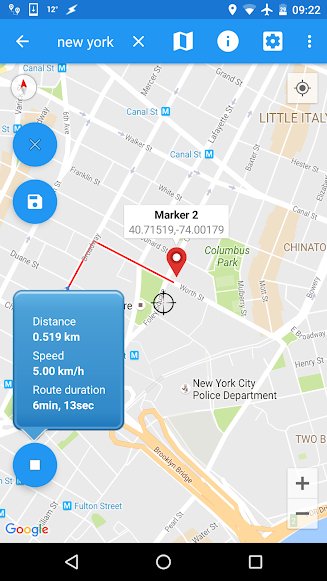
Fake GPS Go is another location spoofer app for Android that is reliable and free. This app allows you to fake your real-time location and enables you to spoof it to any place in the world. This is one of the easiest solutions to playing Pokémon Go while spoofing location without getting detected with its real-map-like UI. Moreover, this app does not even require root access.
- To install Fake GPS Go, go to Google’s “Play store,” search “Fake GPS Go,” and install it.
- Then, go to your phone’s “Settings” and then “System” followed by “About Phone,” and tap on the “Build Number” 7 times to enable the Developer Options.
- Then you need to go to “Debugging” in “Developers Options” to allow “Mock location.”
- And then, you can use this app to not only spoof your location but virtually walk around a route at a designated pace to make it look as real as possible for being undetected by developers like Niantic.
- VPN:

Using a Virtual Private Network (VPN) App is the safest option to spoof your location while playing PoGo, as it masks your IP address and uses a server in any other location.
Moreover, some VPNs would also encrypt your data, so it would not be easy for Game Devs to track it.
- To install a VPN, go to Google’s “Play store,” search the VPN of your choice and install it.
- Close the Pokémon Go app from running in the background to prevent detection of the VPN.
- Now, select a location server to any place before opening the PoGo app again.
Note: Some Free VPNs only mask your IP address and do not spoof your location, nor do they encrypt your data. Hence, selecting a good VPN app is imperative, which will spoof GPS location and data encryption.
You can use both VPNs (which do not spoof GPS location themselves) and the Fake location app simultaneously for extra reliability.
Part 3: Best way to spoof on iOS – dr.fone Virtual Location
Spoofing the GPS location on iPhones is more difficult and much more complex than it is on Android. However, there is a solution. Dr.Fone comes to the rescue with their Virtual Location tool that works seamlessly. This program is easy to use and allows you to simulate your location between 2 and multiple spots with ease. Apart from that you can teleport anywhere with ease. Let us know how this tool works.
Step 1: Download the tool on your PC from the official website of drfone. Select “Virtual Location” given on the first page of the program.

Step 2: Now, have your iPhone connected to your computer. Then select “Get Started”. Now a map will open in a new window, showing your actual location.

Step 3: Enable the “teleport mode” by the third icon in the right-upper corner of the map. Then, enter the location you want to spoof your phone’s GPS to in the text box in the map’s left-upper section. Select “Go”.

Step 4: Now select “Move here.” And you will have successfully spoofed your location on your iOS device. To confirm, open the maps app on your device.

Pro-Tips:
- Do not spoof or change location very frequently, as this might raise suspicion to the Game Dev (Niantic), and the account may get terminated, stating violation of terms.
- Do not use spoofing too frequently. The best way to not get your account suspended is to replicate actual travel patterns.
- Please select a new spoof location and scout it for a couple of days before going to a close-by spoof location. After you are done with the country in the spoof-location, you can move on to neighboring countries before returning to your original location (i.e., switching off the spoof.)
- After you are done with your gaming, always remember to close the game from the background before turning off the spoof location.
- Do not always play with the spoof location. Play with your original location for a couple of weeks before spoofing your location.
- Do not spoof location to countries on different continents within a short time.
Following these tips will help you to behave like an actual traveler who’s on a Pokémon hunt. This will make it even harder for game devs to detect any discrepancies.
Also read:
- [New] 2024 Approved Fine-Tuning the Small Scenes of Minecraft
- 1. Quick Guide: How to Save Video Files in Multiple Formats From PeekVids Using the Latest Downloading Tool
- 10 Best Fake GPS Location Spoofers for Realme Note 50 | Dr.fone
- 11 Best Location Changers for Honor Magic Vs 2 | Dr.fone
- 3 Ways to Change Location on Facebook Marketplace for Apple iPhone 8 | Dr.fone
- 3 Ways to Fake GPS Without Root On Google Pixel 7a | Dr.fone
- 3uTools Virtual Location Not Working On ZTE Axon 40 Lite? Fix Now | Dr.fone
- 4 Methods to Turn off Life 360 On Realme 12 5G without Anyone Knowing | Dr.fone
- A Detailed VPNa Fake GPS Location Free Review On Vivo Y56 5G | Dr.fone
- Demystifying How On-Device AI Works: A Comprehensive Guide
- DOJ's Legal Battle Against Apple: Unpacking the Consequences for iOS Users and Developers | Expert Analysis
- Fix Unfortunately Settings Has Stopped on Samsung Galaxy Z Flip 5 Quickly | Dr.fone
- Guaranteed iPhone Memory Restoration – Your Data Awaits, Purchase Today!
- In 2024, How To Teleport Your GPS Location On Realme 12+ 5G? | Dr.fone
- In 2024, Photographic Experience with Aurora HDR Software
- Title: 3 Ways to Fake GPS Without Root On Samsung Galaxy M34 | Dr.fone
- Author: Mia
- Created at : 2024-12-02 19:59:32
- Updated at : 2024-12-10 03:47:04
- Link: https://location-fake.techidaily.com/3-ways-to-fake-gps-without-root-on-samsung-galaxy-m34-drfone-by-drfone-virtual-android/
- License: This work is licensed under CC BY-NC-SA 4.0.